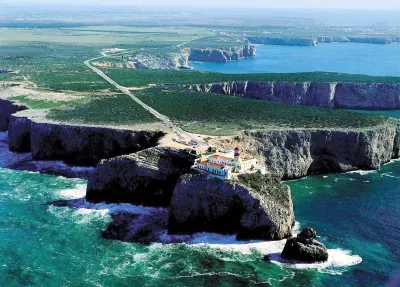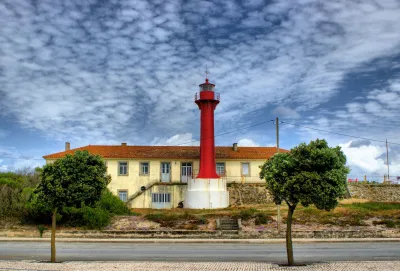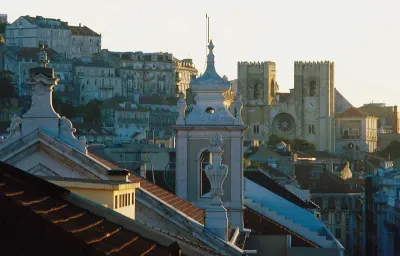Cabo de São Vicente from the air

An aerial view of Cabo de São Vicente (The Cape of St Vincent) on the Algarve's Atlantic coast near Sagres.
With its location in the extreme southwest of Portugal it was once thought by many to be the end of the world. It turns out it wasn't and many of the great Portuguese voyages of discovery set off from near here.
The lighthouse here dates back to the mid 1800s and incorporated the buildings of a 16th century Franciscan convent.
Esposende Fort and Lighthouse

The Farol de Esposende (Esposende Lighthouse) set in front of the Forte de São João Baptista de Esposende. The 15 metre tall lighthouse dates back to 1922 is unusual in that it is made of metal.
The fort dates back to the late 17th century and was built to guard the mouth of the river
Both buildings sit on the northern banks of the river Cávado just behind Esposende's beach
Pousada de Dona Maria I, Queluz

The Pousada de Dona Maria I in Queluz is part of the Pousadas de Portugal network. These provide guest accommodation in some of Portugal's most historic buildings.
The building is also known as the "Torre do Relógio" (clock tower) and sits across the cobbled courtyard from the palace at Queluz. Despite it's Baroque appearance the building is the same age as much of the palace, i.e. late 18th century.
Originally this building was built to house the household servants and members of the Royal Guard. After several other uses over the years it became a pousada in 1995.
Praia da Vau beach

Looking over the rocky point that separates Alvor from the beach at Praia da Vau. The beach here is popular and has its own resort but is just far enough away from Portimão to escape from the major holiday crowds of neighbouring Praia da Rocha.
Nestled away behind the rocks of the point is the lovely little cove of Praia do Barranco das Canas - but you can't quite see it here!
Alfama rooftops

Looking out over the rooftops of the Alfama towards Lisbon's cathedral. This is the old part of town and the cathedral (Sé de Lisboa) is reputedly the oldest building in Lisbon, dating back to 1150.
Praia da Oura - Albufeira

Praia da Oura (Golden beach) is located just around the corner from Albufeira's main stretch of beaches. It is a pretty beach backing onto a promenade lined with restaurants and cafes.
Being a Blue Flag beach makes this a great family beach.
Alfama - Tram and Cathedral

The quintessential view of Lisbon's Alfama district - the number 28 tram and the cathedral (Sé de Lisboa).
This is the oldest quarter of Lisbon and is awash with historic sites. The Alfama still retains a certain degree of authenticity and a trip down any of the maze of side streets will give a glimpse into a Lisbon that has changed little over the centuries.
Cromleque dos Almendres

A closer look at some of the standing stones that make up the Cromleque dos Almendres (Almendres Cromlech) near Evora. The megalithic complex here date back several thousand years to the Stone Age and is, in fact the largest of its type on the Iberian Peninsula. There are 95 granite stones arranged in several formations. Although its exact purpose may never be known it is thought to have some astrological significance.

